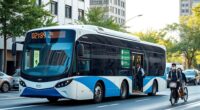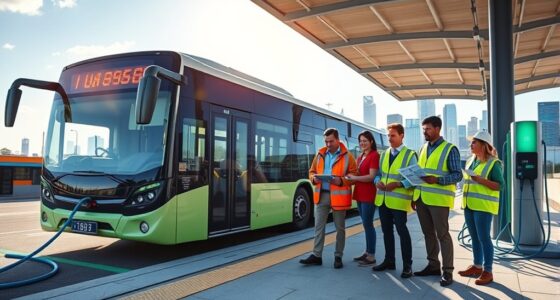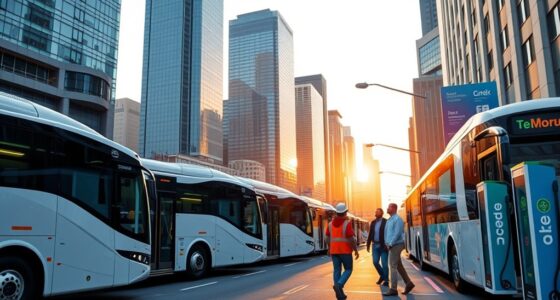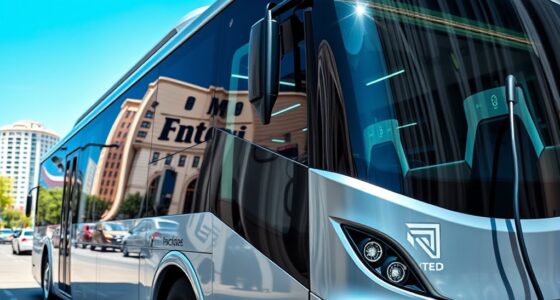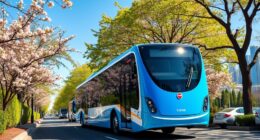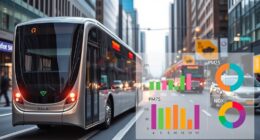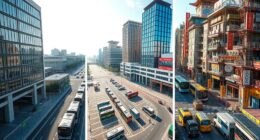Supply chain challenges for electric bus production include component shortages, especially electronics, wiring, and batteries, which cause delays and higher costs. Dependence on foreign battery manufacturers from China, Europe, and the U.S. creates vulnerabilities and inflates prices. Regulatory delays, infrastructure development issues, and high upfront costs further complicate deployment. These hurdles threaten to slow industry growth, but you’ll discover strategies to overcome them as you explore more.
Key Takeaways
- Microchip and electronic component shortages delay manufacturing and limit the integration of advanced features in electric buses.
- Dependence on foreign battery suppliers, primarily from China and Korea, introduces vulnerabilities and increases costs.
- Supply chain disruptions in raw materials and global logistics hinder timely production and inflate expenses.
- Limited availability of standardized components complicates manufacturing processes and raises procurement challenges.
- Infrastructure development hurdles, including high costs and grid upgrade needs, impact deployment and operational efficiency.
Component Shortages and Logistical Bottlenecks

Component shortages and logistical bottlenecks are major hurdles in electric bus production, directly impacting manufacturers’ ability to meet demand. Microchip shortages limit the availability of essential electronic components, causing delays. Electrical component shortages, like wiring harnesses and motors, further slow down assembly lines. Raw materials such as steel are also scarce, increasing costs and extending lead times. Additionally, the importance of high refresh rates in electronic components can exacerbate supply constraints, as advanced features demand more sophisticated and scarce parts.
High demand for these parts intensifies supply chain competition, making it harder for manufacturers to secure what they need. Logistical issues compound the problem—disruptions in global supply chains delay shipments, and reduced factory output, especially in Asia, slows production rates. Transportation challenges add delays, creating backlogs of unfulfilled orders.
These combined factors force manufacturers to operate with higher costs and longer timelines, hindering their ability to keep up with growing demand.
Dependence on Foreign Battery Manufacturing

The global reliance on foreign battery manufacturing poses significant challenges for electric bus production. Most EV batteries come from China, Europe, and the U.S., but Europe and the U.S. depend heavily on imports. China dominates as the largest EV battery exporter, supplying many regions, while Europe’s Hungary and Poland serve as key production hubs thanks to Asian investments. The U.S. imports over 30% of its batteries, mainly from foreign companies like Panasonic, LG, and Tesla. This dependence exposes supply chains to geopolitical risks, trade disruptions, and political tensions. With Korean companies owning about 75% of European capacity and Chinese firms expanding globally, vulnerabilities increase. Such reliance hampers timely production, drives up costs, and complicates efforts to develop resilient, localized supply chains for electric buses. Additionally, fostering creative solutions and innovative manufacturing strategies could help mitigate these vulnerabilities and promote supply chain resilience.
Procurement Practices and Regulatory Delays

Procurement practices and regulatory delays considerably impact the deployment of electric buses. When you adopt standardized procurement and involve stakeholders early, you reduce costs and guarantee operational needs are met.
Partnering with other agencies through joint procurement agreements leverages collective buying power, speeding up processes.
Collaborating with other agencies through joint procurement accelerates purchasing and streamlines deployment.
Implementing configuration management plans keeps design changes controlled, maintaining consistency and cost efficiency.
However, regulatory frameworks can slow progress. You must navigate complex compliance requirements, type approval processes, and certification standards, which can be time-consuming and costly.
Uncertainty or changes in policies may cause delays in procurement decisions.
These regulatory and procedural hurdles can extend timelines, increase expenses, and limit manufacturing capacity, ultimately hindering your ability to deploy electric buses on schedule. Additionally, implementing effective space management strategies within manufacturing facilities can further streamline production workflows and reduce delays.
Infrastructure Development and Deployment Challenges
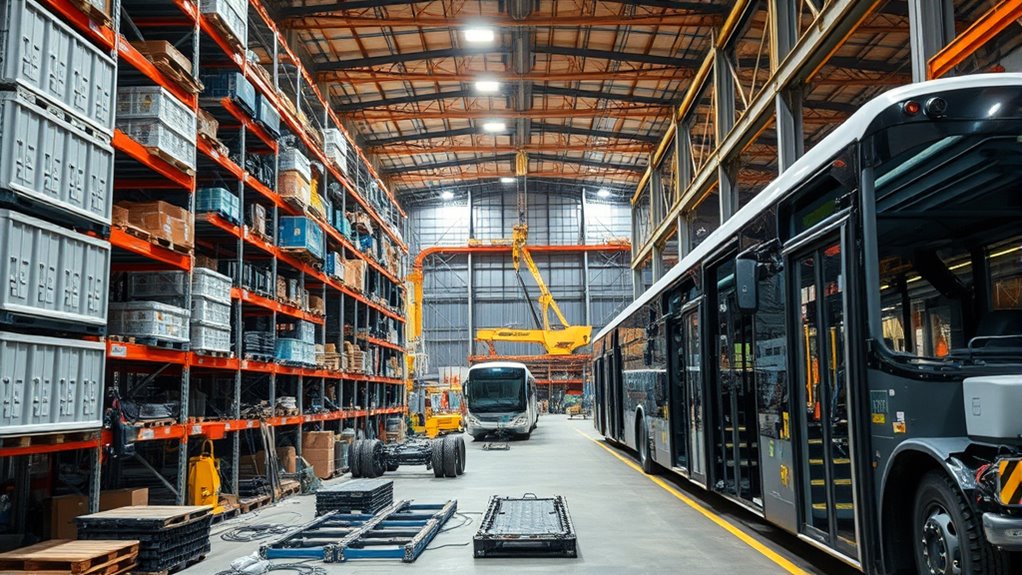
Developing charging infrastructure for electric buses presents significant challenges that can hinder deployment efforts. Land acquisition is difficult, especially in urban areas where securing well-located depots can be costly and complex.
You also need reliable, cost-effective power infrastructure to support frequent charging, which often requires upgrading existing grids. Depot space constraints and the need for scalable charging solutions add further complications, particularly as fleet sizes grow.
High-capacity chargers are essential for heavy-duty buses, but they strain current infrastructure. Additionally, deploying charging stations involves substantial costs—$20,000 to $25,000 per bus—and choosing between centralized and distributed systems impacts planning.
Managing charging schedules, ensuring grid stability, and integrating technology are essential to minimize downtime and maintain service reliability amidst these infrastructure hurdles.
Rising Costs and Financial Pressures
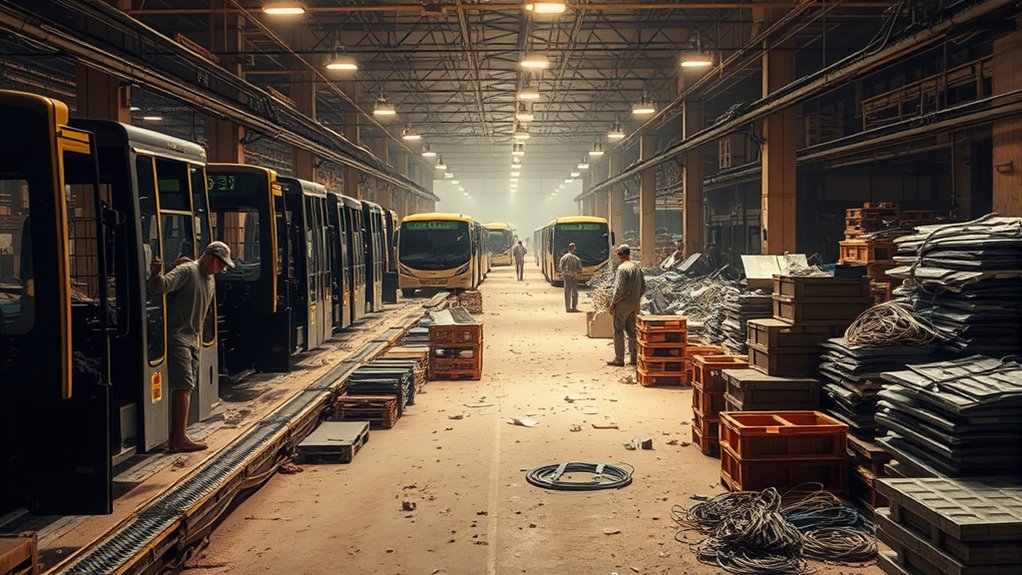
Rising costs and financial pressures pose significant obstacles to the widespread adoption of electric buses. You’ll find that high initial purchase prices—$352,000–$400,000 for electric school buses and around $1 million for transit e-buses—far exceed diesel counterparts, requiring double the fleet capital.
Battery costs are the main driver, especially with larger batteries inflating prices further. European production costs are 30-40% higher, adding to expenses. Dependence on Chinese battery supply chains creates risks, with shortages projected until at least 2030.
Infrastructure investments, like charging stations, add $50k–$200k per bus. While energy savings help, they don’t fully offset upfront costs. Limited range and battery lifespan concerns also increase total ownership costs, making financial viability challenging without sustained public funding and subsidies.
Market Volatility and Policy Uncertainty
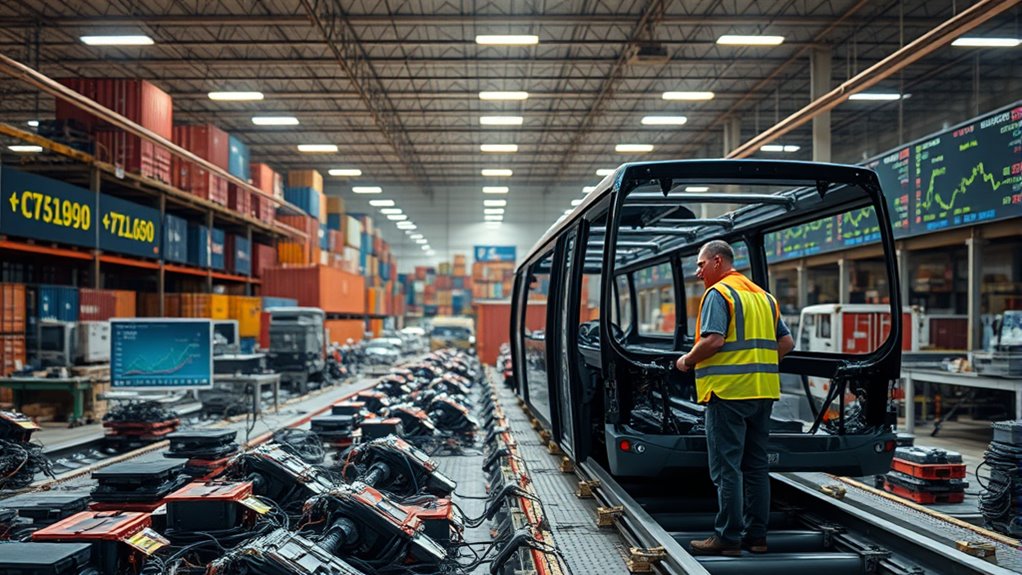
Market volatility and policy uncertainty markedly influence the supply chain stability of electric bus production. Fluctuations in investment can cause shortages of critical components like batteries and charging systems, disrupting manufacturing schedules. Battery shortages are particularly problematic given their importance in electric vehicle manufacturing. Currency exchange rate swings impact the cost of imported parts, adding financial strain. Uncertain regulatory policies can deter investment, delaying product development and market entry. Changes in government incentives affect demand, making it harder to plan production volumes. Additionally, trade policies and tariffs influence component costs and availability, complicating procurement. Evolving standards and infrastructure investments create further unpredictability, forcing manufacturers to adapt quickly. These factors combine to increase risks, challenge supply chain resilience, and hinder the ability to scale production efficiently amid ongoing market and policy fluctuations. Moreover, understanding juice extraction techniques can be useful for diversifying supply sources and improving raw material processing. Adapting to market fluctuations requires robust risk management strategies to maintain production stability and meet growing demand. Ensuring supply chain resilience also involves closely monitoring policy changes and proactively adjusting sourcing strategies.
Overcoming Regional and Technological Fragmentation

Overcoming regional and technological fragmentation is essential for scaling electric bus production and ensuring a unified shift to zero-emission transportation. You need to navigate Asia’s dominance, especially China’s 92% market share, while supporting initiatives like Europe’s “Fit for 55,” which mandates zero-emission buses by 2025.
North America’s efforts, such as the U.S. Clean School Bus Program, show growing federal backing. To succeed, you must address technological diversity—manufacturers like BYD and Proterra offer different models, complicating standardization. Developing uniform charging infrastructure and advancing battery tech are crucial. Promoting cross-regional partnerships and establishing common standards will foster interoperability. Emphasizing the importance of sound design in the development of electric vehicle systems can also facilitate clearer communication of complex technical features to consumers and stakeholders. Furthermore, adopting standardized components can reduce costs and streamline manufacturing processes across markets. Recognizing the role of AI in cybersecurity can help protect these interconnected systems from potential cyber threats, ensuring the safety and reliability of the infrastructure. Additionally, understanding the hours of operation of related supply chain facilities can improve logistics planning and inventory management for electric bus components.
Frequently Asked Questions
How Are Companies Managing Supply Chain Risks During Global Disruptions?
You can manage supply chain risks during global disruptions by diversifying your suppliers, implementing real-time digital monitoring, and developing contingency plans. Building strong partnerships and maintaining ideal inventory levels help you respond quickly to delays.
Emphasize flexibility and adaptability within your operations, embrace innovative technologies like AI and blockchain, and guarantee regulatory compliance. These strategies keep your supply chain resilient, allowing you to navigate disruptions effectively and maintain steady production.
What Strategies Exist to Reduce Dependence on Chinese Battery Imports?
To reduce your dependence on Chinese battery imports, you should diversify your supplier base by partnering with non-Chinese manufacturers and investing in domestic production.
Focus on building local manufacturing facilities, developing advanced battery technologies, and supporting recycling initiatives to create a circular economy.
Exploring international collaborations and establishing strategic alliances can also help you access alternative supply chains, ensuring a more resilient and independent battery supply for your electric bus needs.
How Do Procurement Delays Affect Bus Delivery Timelines?
You’ll see procurement delays directly impact bus delivery timelines by causing manufacturing hold-ups and scheduling uncertainties. When parts or materials aren’t available on time, production slows or stops, pushing back delivery dates.
These delays can also increase costs and complicate planning, forcing you to adjust operational schedules and rely on older vehicles longer. Staying flexible and proactive helps mitigate some effects, but delays still challenge timely deployment.
What Infrastructure Investments Are Most Critical for EV Bus Deployment?
You need to prioritize electrical infrastructure upgrades to deploy EV buses effectively. Upgrading utility-side make-ready infrastructure, including high-voltage line extensions, is crucial.
On the customer side, expanding substations and electrical panels for megawatt-level charging supports fleet needs.
Investing in standardized, interoperable chargers, on-site energy storage, and smart load management ensures reliable, cost-effective charging.
These investments are essential to creating a resilient, scalable EV bus deployment infrastructure.
How Can Manufacturers Mitigate Rising Costs Amid Market Volatility?
Did you know battery prices have dropped by up to 90%, yet costs are now stabilizing? To mitigate rising expenses amid market volatility, you should diversify your suppliers to reduce dependency, relocate production to cost-effective regions, and develop contingency plans.
Implement smart charging and power management strategies to cut operational costs, and build strategic partnerships with governments for subsidies or policy support. These steps help keep your electric bus projects sustainable and resilient.
Conclusion
To navigate these supply chain hurdles, you must adapt quickly—think of it as steering a ship through a storm, much like the pioneers of yore. Embrace innovation, diversify sources, and stay agile in your strategies. Remember, even in the age of the internet, some challenges require the resilience and ingenuity of a 19th-century explorer. Only then can you truly power the future of electric buses and leave the supply chain chaos behind.

